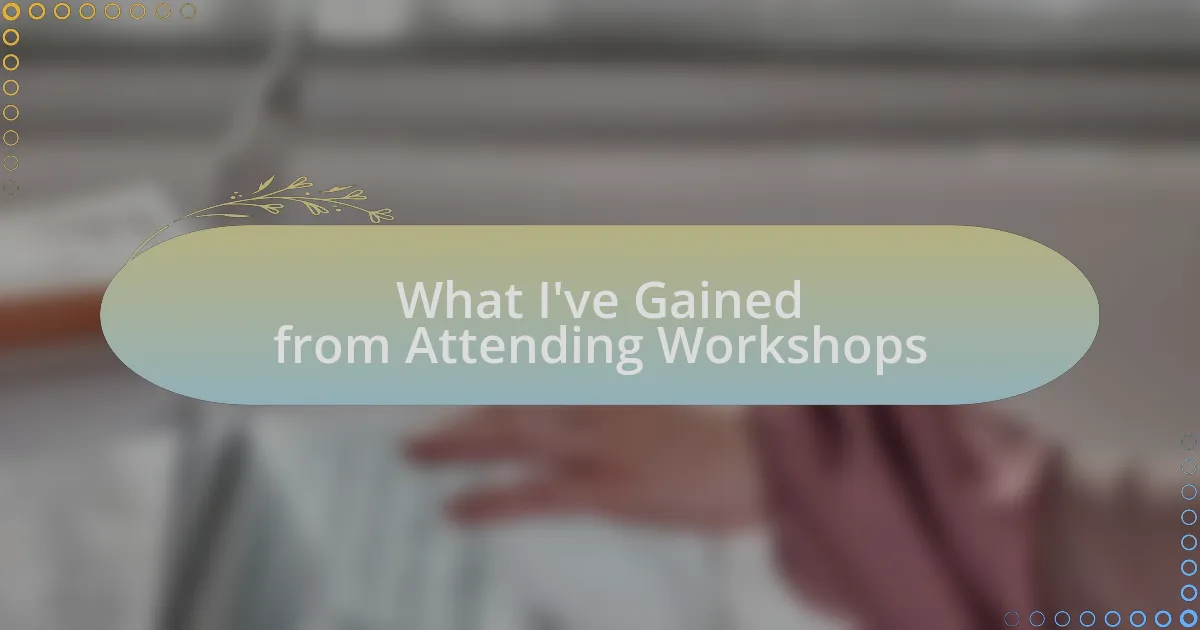Key takeaways:
- Local business networking emphasizes community, fostering genuine relationships that can inspire collaboration and growth.
- Organized community events serve as platforms for networking, driving economic growth while creating a sense of belonging among participants.
- Effective networking strategies include planning, active listening, and timely follow-ups to solidify connections and encourage future collaborations.
- Creating a welcoming atmosphere and being adaptable during events can enhance participant engagement and lead to meaningful interactions.
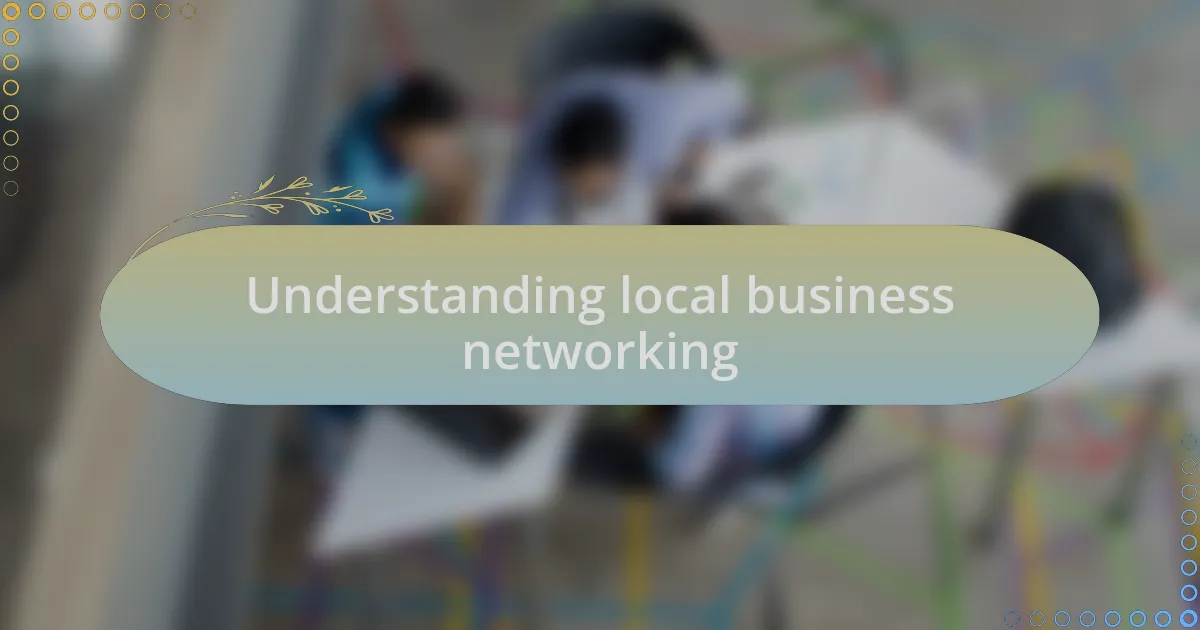
Understanding local business networking
Local business networking is about building connections that create opportunities. I still remember my first networking event; I walked in feeling a bit apprehensive, but it turned out to be a goldmine for meeting passionate entrepreneurs who were eager to share their experiences. Have you ever felt that thrill of connecting with someone who truly understands your journey? Those moments can spark collaboration and inspire growth.
What fascinates me about local business networking is its emphasis on community. I once met a small shop owner who turned their passion into a thriving business, all thanks to relationships forged at networking events. When we come together as a community, we create a supportive ecosystem that allows each member to flourish. Isn’t it refreshing to think that your network can directly influence your success?
Building relationships through local business networking isn’t just about exchanging business cards; it’s about nurturing genuine partnerships. I find it rewarding to collaborate with local businesses, sharing resources and ideas that strengthen us all. Have you ever realized how one insightful conversation can shift your perspective or lead you to your next big opportunity? Embracing these interactions can truly redefine the way we see business in our local environment.
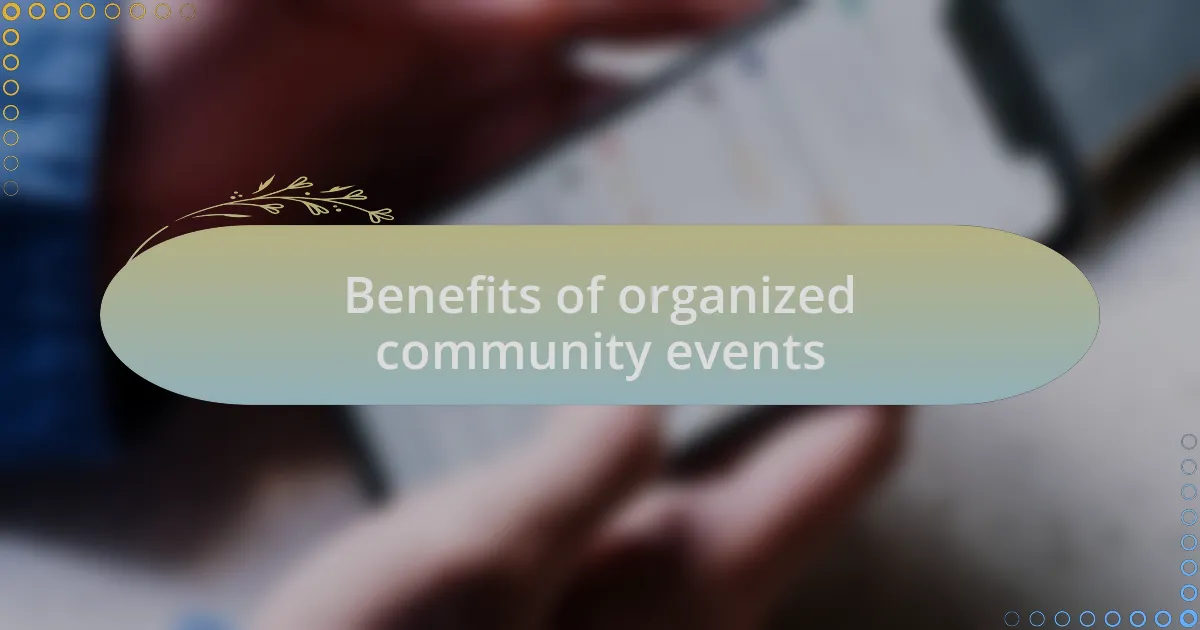
Benefits of organized community events
Organized community events offer a fantastic platform for networking and collaboration. I recall attending a local market where various small businesses set up stalls. The atmosphere was buzzing, and the energy ignited inspiration. Watching people share ideas and learn from one another solidified my understanding of how these events can catalyze partnerships that lead to unexpected opportunities. Have you ever attended an event that left you brimming with fresh ideas and new connections?
Beyond networking, these events foster a sense of belonging. At a recent community festival, I met a fellow entrepreneur who shared my passion for sustainability. We quickly bonded over our visions and decided to collaborate on a project. That collaboration not only helped elevate my business’s mission but also deepened my ties to the community. Isn’t it incredible how a simple gathering can transform strangers into allies in a shared purpose?
Moreover, organized community events can drive local economic growth. When businesses showcase their products together, they attract more visitors, which benefits everyone involved. I’ve seen this firsthand at events where local artisans and service providers band together, ultimately boosting foot traffic and sales. Isn’t it fascinating to think about how collective efforts can lift an entire community? By supporting one another at these events, we pave the way for mutual success and prosperity.
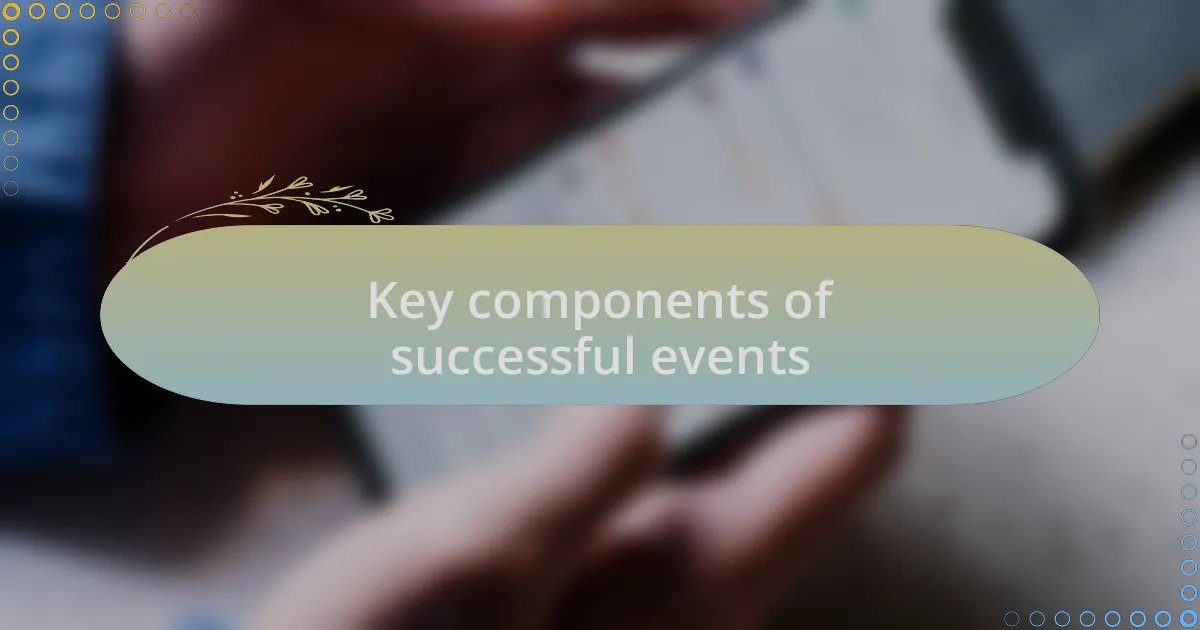
Key components of successful events
When I think about the key components of successful events, organization truly stands out. I remember attending a workshop where every detail, from the seating arrangements to the materials distributed, was well thought out. This planning allowed everyone to focus on networking and learning, rather than fussing over logistics. Have you noticed how a well-organized space can set the right tone for an event?
Another critical element is the ability to foster genuine connections. At a recent networking gala, I watched as a group of local business owners shared personal stories about their challenges and triumphs. This openness created a sense of camaraderie. It’s amazing how sharing vulnerabilities can break down barriers and pave the way for deeper relationships, isn’t it?
Lastly, engaging content keeps attendees interested and motivated. At a community fair, I participated in a panel discussion that addressed pressing local issues. The speakers were relatable, sharing practical insights from their own experiences. I left energized and equipped with new ideas to implement in my own business. Don’t you think that meaningful discussions can be the driving force behind valuable networking?
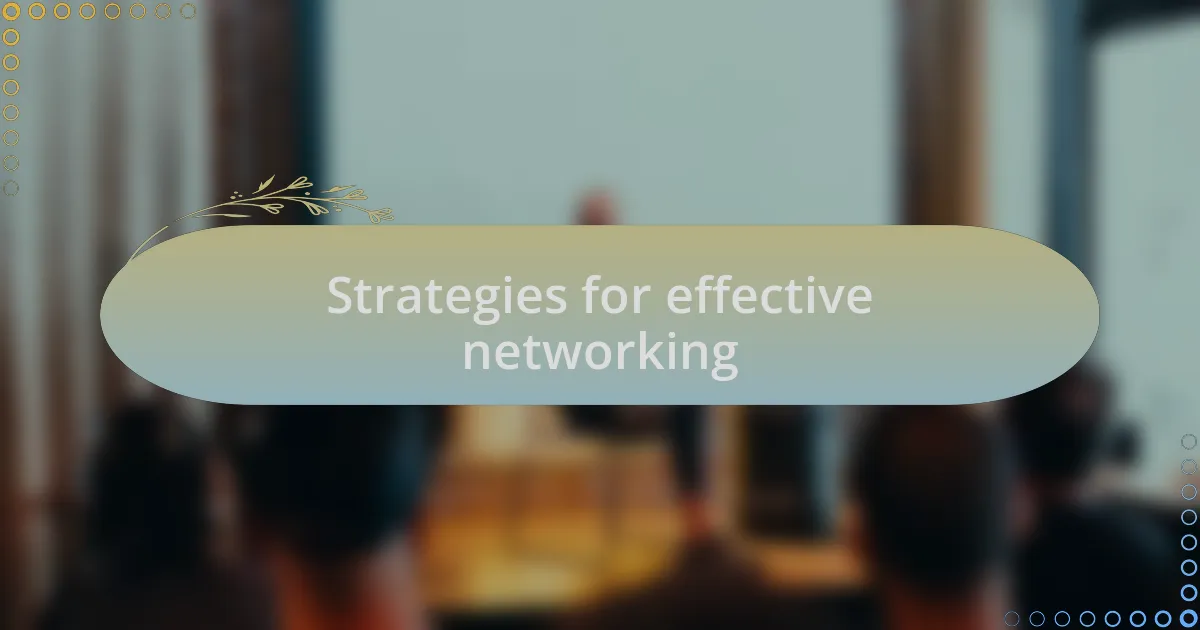
Strategies for effective networking
Developing a plan before attending a networking event is invaluable. I recall a time when I identified key individuals I wanted to connect with at a local business conference. By preparing thoughtful questions and topics to discuss, I felt more confident and ended up making meaningful connections, which led to collaborations I hadn’t anticipated. Have you ever prepared in advance only to discover unexpected opportunities during conversations?
Another effective strategy is to actively listen. It may sound simple, but when I focus on truly engaging with what someone else is saying, I notice how it opens doors to deeper conversations. I remember chatting with a fellow entrepreneur who shared insights about their struggles, and my genuine interest allowed them to share more. This not only helped in forming a bond but also provided me with valuable information that shaped my own approach. Isn’t it fascinating how listening can transform a mere exchange into a rich dialogue?
Finally, following up after an event is crucial. I once attended a networking night where I met several inspiring business owners. Instead of letting those connections fade, I sent personalized messages a few days later to thank them for the conversation and suggest future meetings. It’s rewarding to see how these simple gestures can solidify relationships and keep the networking momentum alive. How often do you follow up with someone you’ve met at an event?
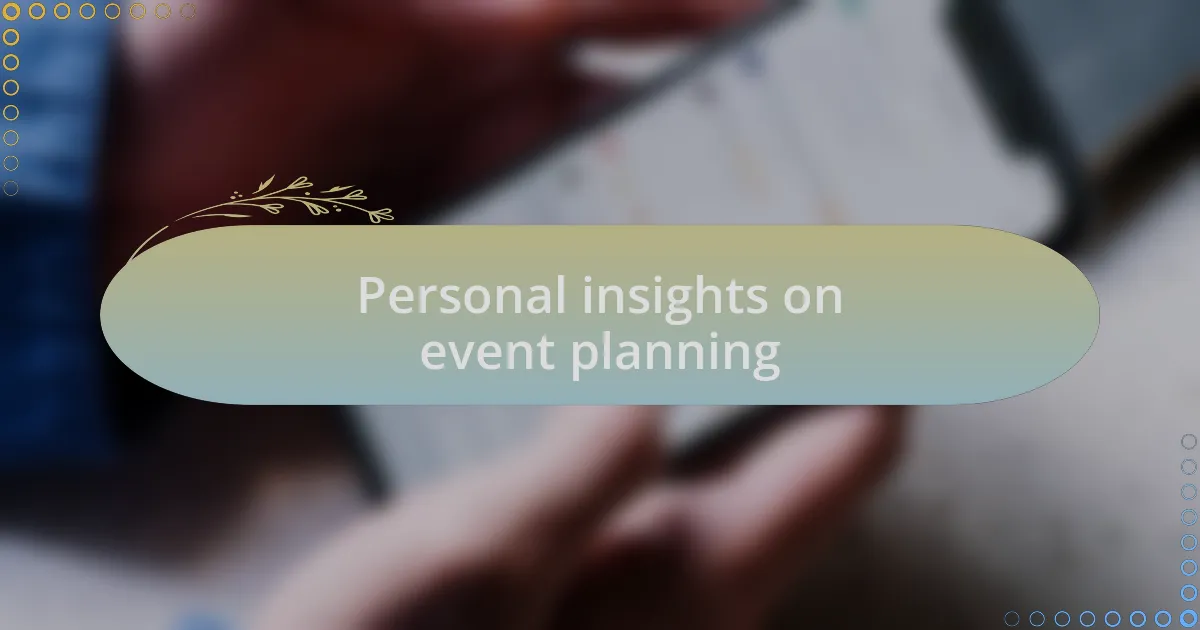
Personal insights on event planning
Planning an event requires an eye for detail and a passion for connection. I once organized a small community workshop and realized that mapping out the schedule meticulously made a huge difference. Each segment flowed smoothly, and I could feel the participants’ excitement building. Have you ever experienced how well-structured plans can amplify energy in a room?
What often stands out to me is the importance of creating a welcoming atmosphere. During an art showcase I coordinated, I put effort into the decor and ambience, ensuring it felt inviting. The feedback I received from attendees made me realize that sometimes, it’s the little things—like comfortable seating or ambient music—that make people feel at home. Isn’t it interesting how setting the right vibe can encourage open conversations?
Finally, I find that flexibility is key during events. At a networking brunch I hosted, we faced unexpected weather changes that forced us to shift our plans. Instead of panicking, I embraced the chaos and redirected the group indoors, where we ended up having a more intimate and engaging discussion. It taught me that adaptability can turn potential mishaps into memorable moments. Have you ever navigated an unexpected situation during your own event, turning it into a positive experience?

Tips for maximizing connections
When it comes to maximizing connections at community events, I believe the power of follow-up cannot be overstated. After my last networking dinner, I took the time to send personalized thank-you notes to attendees, referencing our conversations. Those small gestures not only made people feel appreciated but also opened doors for further dialogue. Have you ever noticed how a simple follow-up can lead to unexpected collaborations?
Creating opportunities for interaction is another strategy I’ve found effective. During a business fair I organized, I incorporated ice-breaker activities that encouraged attendees to mingle. I remember watching a group of strangers transform into a lively discussion, with ideas flowing freely. It’s fascinating how intentional activities can break down barriers and spark genuine connections, wouldn’t you agree?
Lastly, I think it’s vital to leverage social media in the aftermath of an event. After a successful community gathering, I shared photos and highlights on platforms like Instagram and LinkedIn. Engaging with attendees online allowed conversations to continue beyond the event itself. Have you ever thought about how social media can extend the life of your connections and foster a community long after the doors have closed?
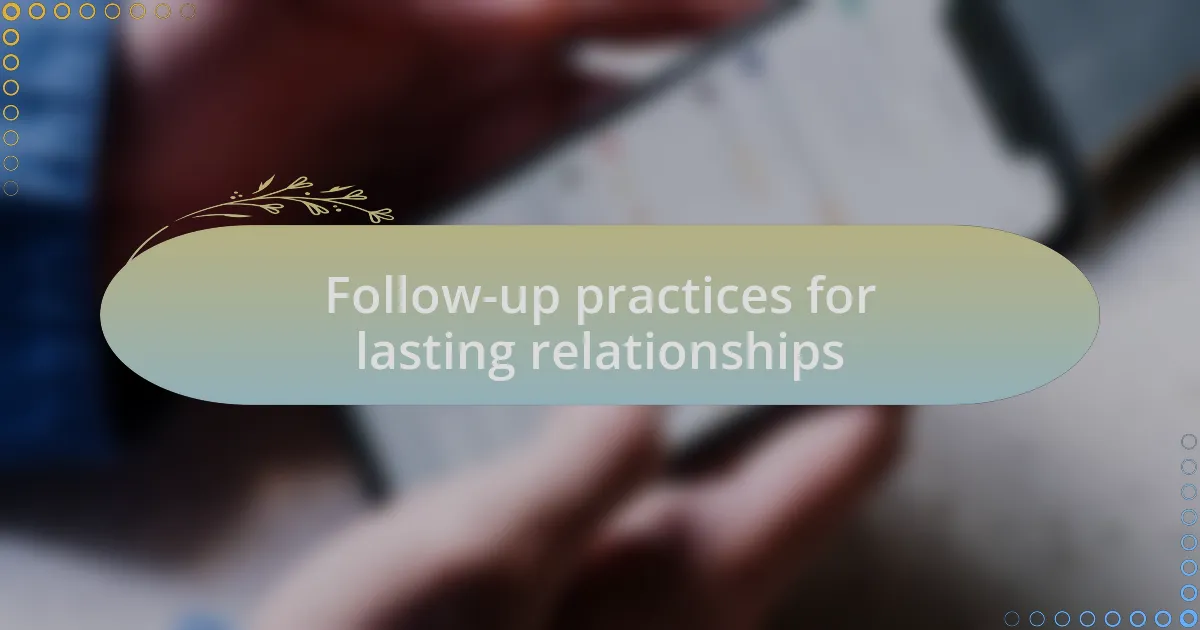
Follow-up practices for lasting relationships
I’ve found that sending a follow-up email within 24 to 48 hours of an event can greatly enhance relationship-building. The last time I did this, I included a takeaway from our conversation that resonated with me. That simple act not only reminded them of our discussion but also showed that I valued their insights. Have you considered how timely follow-ups can reinforce your intentions and keep you top of mind?
Following up doesn’t always have to be formal; sometimes, a light-hearted message or a relevant article can create a comfortable dialogue. I remember chatting with a fellow entrepreneur about a book that inspired our discussion, so I sent them a quick note with the book link a few days later. It sparked a conversation that deepened our connection and led to a collaborative project. How often do you take the opportunity to share resources that align with your discussions?
It’s also important to keep the conversation going. I try to schedule a casual coffee chat or virtual meeting about a month after the initial contact. Recently, I reached out to a contact I hadn’t connected with in a while, and it turned into a brainstorming session that sparked multiple new ideas. Isn’t it interesting how maintaining those connections can yield unexpected opportunities?
